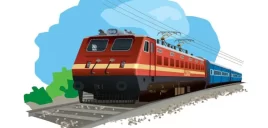Generally, fixed signals have to be provided at all block stations (i.e., classes A, B, and C), except those operating trains under the One Train Only system. The minimal signal provisions for block stations with manual absolute block working are described here. Additional signals may be always be provided based on local requirements. Note that the requirements below are for each direction of approach to the station.
Class ‘A’: In 2-aspect territory, a Warner, a Home, and a Starter signal are provided. In other systems a Distant, a Home, and a Starter are provided. On double-line sections an Advanced Starter is also provided. As the Home signal is the outermost stop signal, the line has to be clear for the appropriate adequate distance (block overlap – 400m for LQ, 180m for MAUQ/MACL/MLQ) beyond the home signal before a train is given permission to approach (i.e., before Line Clear can be granted). The Starter is at an adequate distance beyond the Home. The Warner or Distant follow standard placement guidelines (see below). The Home signal may be bracketed.
This arrangement is suitable in cases where traffic passes through rapidly, and advance knowledge of the condition of the block section is required for the driver. With higher running speeds, it is important that the line be clear for a larger distance (including the section of the line within station limits) before Line Clear is given. The first stop signal is necessarily closer to the station (no Outer signal) and this can create constraints – e.g., if there is an approach gradient near the station, making it inconvenient or unsafe for trains to stop at the Home signal. The disadvantage of the arrangement stems principally from the fact that the line within the station between the home and the starter has to be cleared before Line Clear can be given, which limits working flexibility, shunting, and overall traffic flow.
Class ‘B’: In 2-aspect territory, an Outer and a Home signal for single-line sections, and an Outer, a Home, and a Starter for double-line sections. Warners are provided if train speeds exceed 50km/h. In other systems, a Distant, a Home, and a Starter signal are provided. The main line Home signal usually has a Warner on the same post in modified lower-quadrant working. A shunting limit board is provided in some cases, or an Advanced Starter instead of it. As the Outer signal is the outermost stop signal, the line has to be clear for an adequate distance beyond it (400m for 2LQ, 180m for MLQ, MACL, MAUQ) for Line Clear to be given. A warner is provided in case the run-through speed for the station is over 50km/h.
At single line stations, this arrangement does not provide flexibility for shunting compared to an ‘A’ station, primarily because the shunting activities are still restricted to the portion of the line in advance of the home signal if Line Clear has been given. Therefore, to allow flexibility in shunting activities, the Outer signal is usually placed an additional 180m (beyond the block overlap distance) to the rear of the Home signal, and a Shunting Limit Board appears at the adequate distance in advance of the Outer signal (unless the advanced starter for the other direction appears there, which can be used as the shunting limit marker).
The arrangement of a ‘B’ class station allows two trains to be received simultaneously from either direction without block overlap or signal overlap infringement by either. The two trains must be received on the two loop lines. If one train must be received on the main line, then it is accepted directly and the other train is held at the outer signal by keeping it at danger. ‘B’ stations therefore have higher capacity than ‘A’ stations, as trains can be on on the main and loop lines simultaneously, while other trains can be waiting at either end on the block sections. ‘B’ stations are generally used for most single lines, and also for some double lines (except for suburban stations which for the most part use other arrangements with automatic signalling to increase capacity).
In MLQ signalling, a Distant signal is provided at an adequate distance from the Home signal; the Home is actualy a combination Home and Warner signal or a bracketed home signal with a combination Home and Warner signal for the main line and additional home signals for the loop line(s). When all signals on the bracketed home are on, then the train must come to a halt and not proceed. For loop reception, the main home signal and warner are both on, and the loop home is taken off; the train is expected to proceed at 15km/h on to the loop and stop on the loop. If the main home signal is taken off while the warner is on (with the loop home being on, obviously), the train is expected to proceed at 15km/h on to the main line and stop there. If both the main home signal and its warner are taken off, the train is to run through on the main line.
Under the MAUQ / MACL systems, trains are received as follows on double lines. For reception on the loop line: Distant at attention, Home at Caution for the loop. For reception on the main line, Distant is taken off, Home is at Caution for the main line. For run-through, the Distant and Home for the main line are both taken off.
Class ‘C’: In 2-aspect territory, a Warner and a Home signal are provided. In other systems, a Distant and a Home are provided. The Warner or Distant must be at the braking distance from the Home signal, and should be controlled through block instruments. There is no starter signal, so a train can be received only after the previous train has passed an adequate distance measured from the home signal.
‘C’ stations usually exist only on double lines, as they provide no crossing facilities.
Class ‘D’: No fixed signals need be provided, and the train is stopped for discharging or picking up passengers under any ad hoc arrangement that is suitable.
Unmanned Intermediate Block Posts: The signals for an unmanned intermediate block post are controlled by the station to its rear. Track circuiting is used to ensure that the last train has passed an adequate distance beyond the Home signal of the unmanned IBP before the next train is received.
Source – IFRCA.org

Disclaimer: The Information /News /Video provided in this Platform has been collected from different sources. We Believe that “Knowledge Is Power” and our aim is to create general awareness among people and make them powerful through easily accessible Information. NOTE: We do not take any responsibility of authenticity of Information/News/Videos.
This entry was posted in 2 Railway Employee, STUDY NEW, Railway Employee











